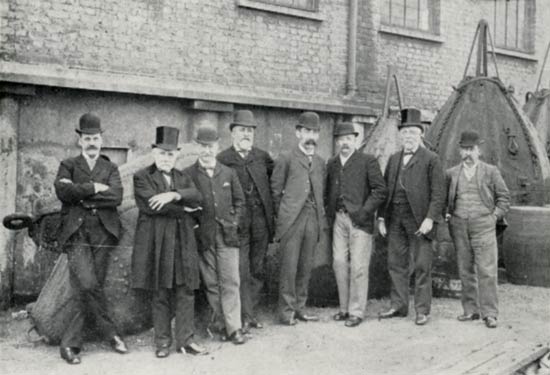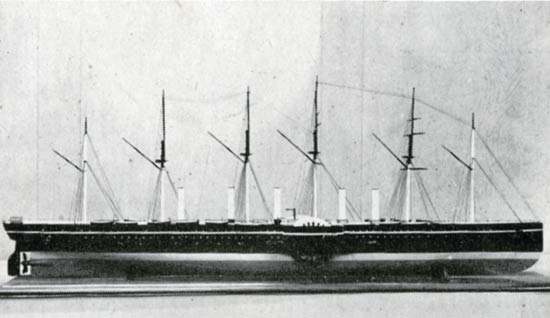The Submarine Cable Electrical Test Staff

Electrical Staff at Greenwich, 1890
Back row: Bill Hintze, F.A. Lovey, Redgrave, J. May, T. Clack
Sitting on buoy: J. Downs, Pinkerton
Front row: Tonking, Donavan, Dr Weatherall, Stevenson, Bob Lewis
Thanks to Allan Green for providing the scan of this photograph. |
From Telcon House Magazine No. 5:
The above photograph shows the Submarine Cable Electrical Test Engineers at Greenwich in 1895 [but note that the photograph is dated 1890 by hand], with the exception of Messrs. Clark (Chief Electrician), Todhunter and Wittrick, who were doubtless at sea, and also possibly of Messrs. Clifford and Riddle. Our correspondent is unable to say definitely whether the two last named were in this department or not.
In those days the duties of the Electrical Test Staff covered a wider field than they do now. The Company then ran its own steam-driven generators and, in addition to cable testing, these men were responsible for electric lighting and power, electric welding, and the telephone system. These latter duties are now undertaken by the separate Electricians' Department.
Many of the instruments then used were extremely delicate, and Dr. Weatherall had a great reputation for his skill in repairing not only these, but also all the sundry watches which had ceased to function properly. Rather an autocrat in his own sphere of work, he would brook interference from nobody.
Mr. Tonking was known as the inventor of the Tonking test key which is still in use to-day. Mr. Stevenson's stately progress through the factory on his daily tour of inspection was the signal for the youngsters (one of them our Mr. F. Foster) to scuttle away like rabbits and get very busy. Incidentally, Mr. Foster remembers that one of his duties was to run up the road every morning with a large medicine bottle and buy twopenny worth of gin for one of these gentlemen who shall remain unnamed.
The building seen in the photograph was known as the Oil Store and still exists near the Tape Slitting Shop and Enderby House. The old type cable buoys are also of interest.
|
When the photograph was published in the Telcon House Magazine No. 5 in 1949 it generated a number of comments from old-timer readers, and another photograph from the same period was printed in the next issue (No. 6) with this letter:
DEAR SIR,—I see you show in your last Magazine a reprint of the photo of the Electrical Staff at Greenwich in 1895, and are in doubt regarding certain members not in this group.
I enclose a photograph which, I believe, was taken at the same time, and which will account, I think, for some of the missing members you refer to.
As far as my memory helps me (reading l. to r.) No. 2 is Mr. Clifford, No. 3 Mr. Riddle ?, No. 6 Mr. Todhunter ?, No. 7 Mr. R. London, and No. 8 Mr. Churchill.
You are at liberty to retain both these originals if only for your museum.—Yours faithfully, CHARLES MAY, 17, Cedarhurst Drive, Eltham, London, S.E.9.
[The above letter was addressed to Mr. Lawford. As far as we have been able to ascertain from the older employees still with us, and with the aid of the names supplied by Mr. May, the complete list is as follows (l. to r.): Messrs. Lucas, Clifford, Riddle, Sherwin, Corder, Todhunter, London, Churchill.—ED.]

Frank R. Lucas, Henry Clifford, Chas. Crook,
Sherwin, Corder, Todhunter, London, Churchill |
In the same issue there was also this letter from Marian Clifford, Henry Clifford’s daughter-in-law:
DEAR SIR.—My husband, Alexander Clifford, has asked me to write and tell you how very much he appreciates the Magazine.
He is especially interested in this last, No. 5, which mentions his father, Mr. Henry Clifford, and he wishes me to tell you Mr. Clifford was never an Electrical Test Engineer. He was Chief Engineer and designed all the paying-out gear for both the 1858 and 1866 Atlantic Cables which is, I believe, the same in principle as that used to-day; he also introduced the brass tape serving for cables as a protection against the teredos. Later, Mr. Henry Clifford was Managing Director, and was followed by Mr. Frank R. Lucas.
On page 12 you show a photograph of the working model of the ‘Great Eastern’ which we presented to the Telegraph Construction and Maintenance Co., Ltd., in 1927, and which was made at the works for Mr. Henry Clifford many years before. If we can be of any help to you in verifying dates, etc., from Mr. Clifford’s diaries, we shall be only too pleased. Yours Sincerely, MARIAN G. CLIFFORD, Carriers, Lindfield, Sussex.
Alexander Clifford had also worked at Telcon, from April 1893 until his retirement on 31 December 1927.
Here is the photograph and story of Henry Clifford’s model of Great Eastern from Telcon House Magazine No. 5 (1949).

“THE GREAT EASTERN”
This ship, which figures so prominently in the early history of submarine cable laying, held the record as the world’s largest ship for close on forty years, and her dimensions were not exceeded until about ten years after she was broken up.
It was I. K. Brunel (seen in the old photograph reproduced on p. 16 of Telcon House Magazine, No. 3) who designed the ship and supervised its construction at Millwall. Unfortunately he lived only just long enough to witness her trials.
In these works we have an excellent working model, roughly five feet long (the actual ship was 692 feet long) of the “Great Eastern” as the above photograph shows. The paddles are driven by steam and the screw by a small clockwork motor which runs for five minutes. The model, which is some 60 years old, was sent to the Chicago International Exposition held in the early 1930’s and returned only after the outbreak of the second world war. During the war it was seriously damaged by bomb blast, but it has been carefully reconditioned and once again looks as good as when first constructed.
|
Oddly, the model has five funnels, even though one funnel had been removed in 1865 when Great Eastern was fitted out by Telcon for cable laying. Henry Clifford, who was also a skilled artist, had painted the ship in this configuration many times, so it is hard to understand this error in the model.
Another photograph of the model appeared in Telcon House Magazine No. 22 (1953) as part of a feature on James Dugan’s just-published book, “The Great Iron Ship.” The photograph was taken at "Telcon Works."
Finally, in an article in Telcon House Magazine No. 39 (1958) about a summer exhibition at the National Maritime Museum titled "Sail to Steam," the same photo is accompanied by this description:
This year the National Maritime Museum adopted the theme "Sail to Steam" for its summer exhibition in logical succession to last year's "Heart of Oak" display. The exhibition illustrates the evolution of the steamship proper through the sailing ship with auxiliary engines and the steamship which still had sails and will remain open until the end of the year.
As many of our readers know, our Company had in its possession a working model of the Great Eastern, masterpiece of that famous engineer of the Victoria era, Isambard Kingdom Brunel. Ahead of its time in design, no profitable use could be found for this great iron ship until our Company chartered it for laying submarine telegraph cables, among them the first successful transatlantic telegraph cable.
This model, shown in the photograph above, was constructed about 70 years ago, that is to say about the time the ship itself was being broken up. It is about 5 ft. long and its paddles are driven by steam and its screw by a small clockwork motor which runs for about five minutes.
Quite rightly our Directors decided some time ago that the model would be of the utmost interest to the thousands of visitors to the National Maritime Museum and offered it to the trustees. The offer was gratefully accepted and, by coincidence, the date fixed for the formal transfer of the model to the Museum was that on which the "Sail to Steam" exhibition was opened by Sir Alan Herbert, May 21.
Sir John Dean, our chairman, accompanied by Dr. E. W. Smith, Mr. F. S. H. Lemon and Mr. A. D. Lidderdale, made the presentation in the Caird Galleries in the presence of Mr. F. G. G. Carr, Director of the Museum. The model was accepted on behalf of the museum by Dr. K. C. Anderson, who deputized for the Chairman of the Trustees.
There remains some confusion about this model which remains to be resolved, as follows:
Two models of Great Eastern are listed in the NMM's collection catalogue. The first one is "Great Eastern (1858); Passenger vessel; Liner" ID SLR090, and the entry includes six photographs. This model has five funnels.
The description notes that "Model is decked, fully rigged and complete with a working steam engine internally" and "The paddle wheels on either side of the hull rotate on a crankshaft, which has been disconnected from the main engine." The length is given as 1525mm (5 ft).
With five funnels, a working steam engine and paddlewheel drive, and its 5-ft length, this would appear to be the model of Great Eastern made by Telcon around 1888 and donated by the company to the NMM in 1958, as reported above.
However, the paint scheme of the hull appears different, and the NMM listing also has a link to a photo of a brass plaque which accompanies the model and includes this description: "Working model constructed by John Scott Russell before the building of the ship in 1857."
The NMM's second model is: "Great Eastern (1858); Passenger/cargo vessel; Cableship" ID SLR0904, and the entry has 14 photographs. The ship has four funnels, as is correct for Great Eastern as a cable ship, and its brass plaque reads "Cable Ship Great Eastern." There is no mention of any moving parts and the length is given as 1105mm (3' 7"), so this is clearly not the Telcon model.
So was the NMM's first model built by John Scott Russell in 1857? If so, where is Telcon's model, built around 1888 and donated to the museum in 1958?
For more information on the
Telegraph Construction & Maintenance
Company (Telcon) and cable making at Greenwich, see
Cable Work at Greenwich
A
Photographic View of Enderby's Wharf in 2004 and
150 Years Of Industry & Enterprise At Enderby's Wharf |

